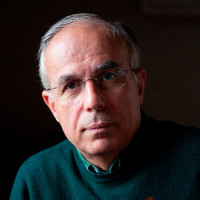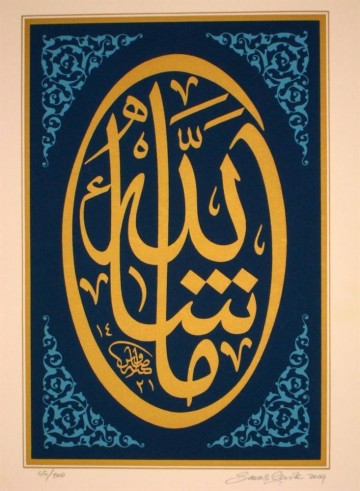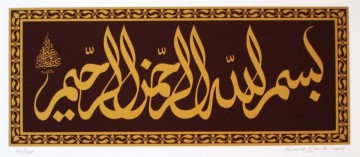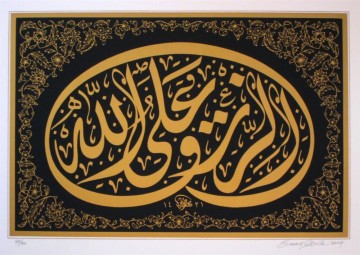萨瓦什•切维克

萨瓦什•切维克
伊斯坦布尔,土耳其
书法家、都斯大学平面造型艺术系讲师
Calligraphy in the Islamic World
expressed in the material world
Calligraphy is the most popular direction among the many directions of Islamic art: according to the Prophet’s maxims, a calligrapher who will manage to re-write God’s Word (Koran) in beautiful handwriting will live in heaven after his death. This art started to develop after Arabs had got the sacred text of the Koran. The basis of calligraphy is fed from a spiritual source – the information received from on high, through the “modified conscience” of the Prophet. The word 'Koran' means reading, declamation; so Mohammed himself did not write down the text but just repeated it by heart for control purposes for the last time before his death. And a bit later, his closest supporters and pupils, having gathered odd records made under the Prophet Mohammed and not relying on their memory, drafted the final cannon of the Sacred Text. Calligraphy began prospering at the very early stages of Islamic history; soon the ugly and scratchy letters of the Semitic alphabet turned into decorative ones.
Immediately after the Sacred Koran was consolidated into a book, numerous scribes were specially taught for the best expression of revelation and spirituality. At first, the full text of the Koran was re-written on processed animal skins using a cane pen; pages were rectangular, with a long foundation, and it was not until the 10th century that the Koran started to be copied in the eastern part of the Islamic world on pages of ordinary form. In combination with the greatest importance assigned by Islam to science and literature, the art of writing turned into a distinctive feature of visual art. The world known artist Picasso, when seeing a calligrapher master’s work, could not restrain his emotions and exclaimed: “This is art!” He became a witness of genuine aesthetics – Islamic calligraphy.
It is based on six styles known as the Aklami Sitte, or Seskalem, developed in the 13th century, in the city of Bagdad, by a well-known calligrapher Yakut. These styles are Sulus, Nesikh, Muhakkak, Reyani, Tevki, and Rika. However, Islamic calligraphy has its own rules developed and introduced under Fatikh by sheikh Hamdulla Amaziisky. Other styles in Islamic calligraphy are Kufi, Rika, Divani, Siakat. So far, the art of calligraphy has passed a number of changes in centuries, striking life into invaluable work. Turkish calligraphy is a combination of letters of the Latin alphabet introduced at the time of establishment of the Turkish Republic in the 20th century, with Islamic Calligraphy (Husni Hut); this is a reflection of the writing of Latin letters in accordance with the calligraphy aesthetics that found recognition and caused genuine interest in the last thirty years.
Enlightenment (Tejib)
The word of Tejib originates from the Arabic word meaning the art of decorating manuscripts, such as the Holy Koran. An artist practicing this art is called a Muzehhib. Work by Turkish and Persian masters determined the way to the Style of the Heart in the second half of the 15th century and that lasted till the start of the 17th century. Many artists were trained in the Empire School of Décor but it is Baba Nakkas who is considered the founder of the trend. Tajib Art was in great demand and was supported by the Royal Court and, despite the influence of baroque and rococo in the 18th century, the significance of this art was not lost.
Islamic Calligraphy on Processed Leaves
Leaves, mostly of poplar and chestnut, were collected at a certain time, were selected and specially processed to ensure long-term storage and matured for a year. Then a calligraphic composition is drawn on leaves using flax oil manually made by a calligrapher artist.
A tree leaf in Islamic mysticism symbolizes the unity of the universe. Like the being at the macro-level in each person, the leaf itself reflects a part of the soul and the development cycle of the tree and life itself. In this case, calligraphy is united with the Universe.
The impressive symbolic resemblance between a tree leaf and the heart became the principal factor for recognizing this calligraphy trend. Direct interrelation between this philosophic concept and a human being with their beliefs starts in this particular form. Calligraphic work on leaves is one of the most significant contributions of Turkish Art into Islamic art.
Miniature
Initially emerged in Central Asia and the Far East in the 6th century, miniature was first introduced in Anatolia and started to be disseminated in Turkey. The 16th century virtually became a golden age for it when miniature became as a significant art in the Ottoman Empire as the multitude of others. The majority of miniatures depicted scenes of war, hunting, significant events, lifestyle of people, which made them historical.
Two miniature styles exist – Ottoman and Persian. In the Ottoman miniature, unlike with the Persian one, a simpler and less bright description is preferable to underline the documentary aspect. The principal distinctive feature of work belonging to these two trends is their two-dimensional capacity to show a picture using light, shadow effect and perspective. Relying on a great variety of materials – paper, ivory and marble – the miniature attracts general attention by the number of original work, copies and work of an entirely new plan.
Tugra
The most surprising phenomenon among official historic documents originating from the Divan (the national council of Turney) is Tugra – the intricate method of the Sultan’s personal signature, a sort of monogram used for giving governmental authority to and legalization of decrees. The word of Tugra is derived from the word of “tugrag” that means “the emperor’s monogram and decree”. Initially used on written documents only, it was extended to seals, coins and stamps. There are many theories explaining the image of Tugra. According to one of them, it depicts a fairy-tale bird resembling an eagle and called tugri. It was a totem of the Gagayuz Turks who used to live in the Balkans.
Being one of the most significant types of art in Turkey, tugra has inimitable examples, both on paper and on silk and leather. Poems, hadits and certain legends written in the form of tugra are of great interest to art lovers.
Ferman
The word of ‘Ferman’ is derived from the Persian word of “fermundan” that means ‘team’ or ‘order’. Used by Ilkhans after Islam was adopted, this word began to be widely used in the diplomatic life of the Ottoman Empire. In any event, this word meant an order supported by Tugra. Conventionally written in the calligraphic style of the Divan, Fermans comprised the following parts: the main part was an invitation that the applicant supported with Tugra; it was followed by the Ferman part that consisted of names and addressees with the words of favourable response, the introductory part, the purpose of application, sultan’s provisions, explanations, warnings, urgent requirement and date. At present, copies of Ferman tests written in the same ink and the same style are the objects of increased interest.
Marble Painting (Hebrou)
A mixture of tragakant (a viscous substance that is obtained from bushes) and water is made in a big jug. Powder colours sprinkled on the water surface and tragakant mixtures are pasted on the surface of a wet absorbing paper that is suitable for drawing images on it. Hebrou masters made their brushes from rose stalks and horse hair using traditional examples.
Etching
The discovery of the art of etching started with the discovery of the 15th century works of art, in particular, Albrecht Durer (1471 - 1528). The meaning of etching consists in application of images on the surface of such soft materials as copper, zinc and brass, using metallic posts or application of the image using brushes and ink.






